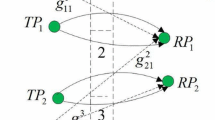Abstract
In this paper, we present a heterogeneous network framework involved an orthogonal frequency division multiple access (OFDMA) network with an out-of-band Ad Hoc network, which maybe a promising architectural upgrade and has not been studied so far. In the heterogeneous system, the mobile stations (MSs) are dual-mode with both cellular OFDMA and Ad Hoc radios. And MSs communicate with the base station by cellular OFDMA mode, while they communicate with each other by Ad Hoc mode. An active MS can choose multiple inactive MSs as its relay stations (RSs). And each RS operates in a full duplex mode, that is, it can receive data through Ad Hoc network in the first hop and transmit data through the OFDMA network in the second hop, simultaneously. Based on this heterogeneous system, the problem of joint relay selection, subcarrier and power allocation with the objective of maximizing the system capacity under individual rate and transmit power constraints is addressed. We propose a dual-based resource allocation scheme to solve the problem fairly and efficiently, and then we propose a fully distributed resource allocation scheme to decrease the computational complexity. Simulation results show that the performance of the proposed dual-based resource allocation scheme, in terms of the system capacity and the outage probability, is better than that of the fully distributed resource allocation scheme. However, the performance improvement is at the expense of a high computational complexity.
Similar content being viewed by others
References
Kim K., Han Y., Kim S.-L. (2005) Joint subcarrier and power allocation in uplink OFDMA systems. IEEE Communications Letters 9(6): 526–528
Gao L., Cui S. (2008) Efficient subcarrier, power, and rate allocation with fairness consideration for OFDMA uplink. IEEE Transactions on Wireless Communications 7(5): 1507–1511
Ma Y., Kim D. (2009) Rate-maximization scheduling schemes for uplink OFDMA. IEEE Transactions on Wireless Communications 8(6): 3193–3205
Beres E., Adve R. (2010) Optimal relay-subset selection and time-allocation in decode-and-forward cooperative networks. IEEE Transactions on Wireless Communications 9(7): 2145–2155
Bhatia R., Li L., Luo H., Ramjee R. (2006) ICAM: Integrated cellular and ad hoc multicast. IEEE Transactions on Mobile Computing 5(8): 1004–1015
Laneman J. N., Tse D. N. C., Wornell G. W. (2004) Cooperative diversity in wireless networks: Efficient protocols and outage behavior. IEEE Transactions on Information Theory 50(12): 3062–3080
Le L., Hossain E. (2007) Multihop cellular networks: Potential gains, research challenges, and a resource allocation framework. IEEE Communications Magazine 45(9): 66–73
Maric I., Yates R. D. (2010) Bandwidth and power allocation for cooperative strategies in gaussian relay networks. IEEE Transactions on Information Theory 56(4): 1880–1889
Quek T. Q. S., Win M. Z., Chiani M. (2010) Robust power allocation algorithms for wireless relay networks. IEEE Transactions on Communications 58(7): 1931–1938
Zhao D., Todd T. D. (2006) Cellular CDMA capacity with out-of-band multihop relaying. IEEE Transactions on Mobile Computing 5(2): 170–178
Tang Z., Zhu Y., Wei G., Zhu J. (2008) An OFDMA-based subcarrier and power allocation scheme in wireless cooperative cellular systems. Wireless Personal Communications 48(2): 277–289. doi:10.1007/s11277-008-9522-1
Li H., Luo H., Guo J., Li C. (2012) Dynamic resource allocation in OFDMA-based DF cooperative relay networks. Wireless Personal Communications 62(3): 655–670
Li G., Liu H. (2006) Resource allocation for OFDMA relay networks with fairness constraints. IEEE Journal on Selected Areas in Communications 24(11): 2061–2069
Dang W., Tao M., Mu H., Huang J. (2010) Subcarrier-pair based resource allocation for cooperative multi-relay OFDM systems. IEEE Transactions on Wireless Communications 9(5): 1640–1649
Yu, W., & Lui, R. (2006). Dual methods for nonconvex spectrum optimization of multicarrier systems. IEEE Transactions on Communications, 54(7), 1310–1322.
Toumpis S., Goldsmith A. J. (2003) Capacity regions for wireless ad hoc networks. IEEE Transactions on Wireless Communications 2(4): 736–748
Bletsas A., Khisti A., Reed D. P., Lippman A. (2006) A simple cooperative diversity method based on network path selection. IEEE Journal on Selected Areas in Communications 24(3): 659–672
Papandriopoulos J., Evans J. S. (2009) SCALE: A low-complexity distributed protocol for spectrum balancing in multiuser DSL networks. IEEE Transactions on Information Theory 55(8): 3711–3724
Boyd S., Vandenberghe L. (2004) Convex optimization. Cambridge University Press, New York
Boyd, S., & Mutapcic, A. (2006–2007). Subgradient methods. Notes for EE364b, Stanford University.
Boyd S., Kim S.-J., Vandenberghe L., Hassibi A. (2007) A tutorial on geometric programming. Optimization and Engineering 8(1): 67–127. doi:10.1007/s11081-007-9001-7
Boyd, S. (2006) Convex optimization II. EE364B Course Note, Stanford University. Available at http://www.stanford.edu/class/ee364b/ .
Palomar D. P., Fonollosa J. R. (2005) Practical algorithms for a family of waterfilling solutions. IEEE Transactions on Signal Processing 53(2): 686–695
Author information
Authors and Affiliations
Corresponding author
Rights and permissions
About this article
Cite this article
Han, X., Chen, H., Xie, L. et al. Resource Allocation Schemes for the Heterogeneous OFDMA System with Multiple Ad Hoc Relays. Wireless Pers Commun 69, 487–508 (2013). https://doi.org/10.1007/s11277-012-0585-7
Published:
Issue Date:
DOI: https://doi.org/10.1007/s11277-012-0585-7




